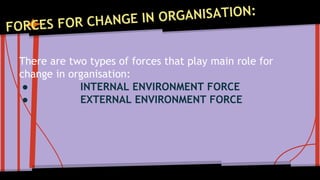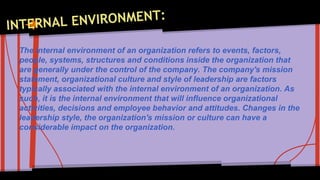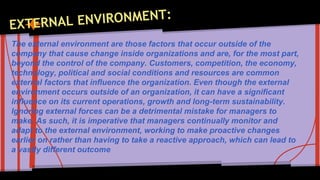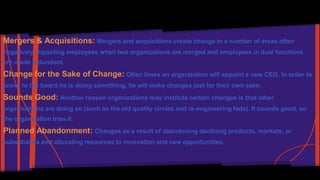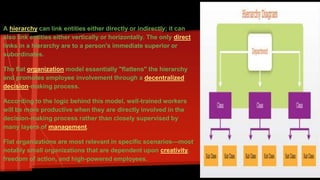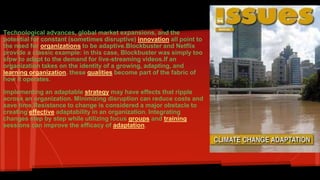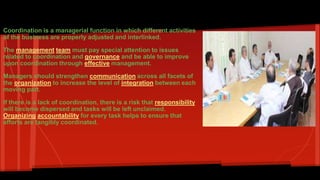Organisational change and devlopment
- 1. PRESENTED BY: VISHAL SINGH MCA(053) LBSIM
- 2. Change management is an approach to shifting or transitioning individuals, teams, and organizations from their existing state to a desired future state. Examples of organizational change can include strategic, operational, and technological changes coming from inside or outside the organization. Understanding key internal and external change catalysts is critical to successful change management for organizational leaders.
- 3. MODEL FOR MANAGING CHANGE: There are basically three types of model for managing changes in organisation. Most companies will choose at least one of the following three model to operate under: Lewin’s change management model McKinsey 7-s model Kotter’s 8 step change model
- 4. This change management model was created in the 1950s by psychologist Kurt Lewin. Lewin noted that the majority of people tend to prefer and operate within certain zones of safety. He recognized three stages of change: 1. Unfreeze – Most people make an active effort to resist change. In order to overcome this tendency, a period of thawing or unfreezing must be initiated through motivation. 2. Transition – Once change is initiated, the company moves into a transition period, which may last for some time. Adequate leadership and reassurance is necessary for the process to be successful.
- 5. 3. Refreeze – After change has been accepted and successfully implemented, the company becomes stable again, and staff refreezes as they operate under the new guidelines. While this change management model remains widely used today, it is takes time to implement. Of course, since it is easy to use, most companies tend to prefer this model to enact major changes.
- 6. The McKinsey 7-S model offers a holistic approach to organization. This model, created by Robert Waterman, Tom Peters, Richard Pascale, and Anthony Athos during a meeting in 1978, has 7 factors that operate as collective agent of change: 1. Shared values 2. Strategy 3. Structure 4. Systems 5. Style 6. Staff 7. Skills
- 7. The disadvantages of the McKinsey 7-S Model are: - When one part changes, all parts change, because all factors are interrelated. - Differences are ignored. - The model is complex. - Companies using this model have been known to have a higher incidence of failure.
- 8. This model, created by Harvard University Professor John Kotter, causes change to become a campaign. Employees buy into the change after leaders convince them of the urgent need for change to occur. There are 8 steps are involved in this model: 1. Increase the urgency for change. 2. Build a team dedicated to change. 3. Create the vision for change 4. Communicate the need for change. 5. Empower staff with the ability to change 6. Create short term goals. 7. Stay persistent. 8 . Make the change permanent.
- 9. Significant advantages to the model are: - The process is an easy step-by-step model. - The focus is on preparing and accepting change, not the actual change. - Transition is easier with this model. There are some disadvantages offered by this model: - Steps can’t be skipped. - The process takes a great deal of time.
- 10. There are two types of forces that play main role for change in organisation: ● INTERNAL ENVIRONMENT FORCE ● EXTERNAL ENVIRONMENT FORCE
- 11. The internal environment of an organization refers to events, factors, people, systems, structures and conditions inside the organization that are generally under the control of the company. The company's mission statement, organizational culture and style of leadership are factors typically associated with the internal environment of an organization. As such, it is the internal environment that will influence organizational activities, decisions and employee behavior and attitudes. Changes in the leadership style, the organization's mission or culture can have a considerable impact on the organization.
- 12. The external environment are those factors that occur outside of the company that cause change inside organizations and are, for the most part, beyond the control of the company. Customers, competition, the economy, technology, political and social conditions and resources are common external factors that influence the organization. Even though the external environment occurs outside of an organization, it can have a significant influence on its current operations, growth and long-term sustainability. Ignoring external forces can be a detrimental mistake for managers to make. As such, it is imperative that managers continually monitor and adapt to the external environment, working to make proactive changes earlier on rather than having to take a reactive approach, which can lead to a vastly different outcome
- 13. There is nine reasons to explain need for change in organisation: 1. Crisis 2. Performance gap 3. New technology 4. Identification of opportunities 5. Reaction to internal and external pressure 6. Mergers and Acquisition 7. Change for the sake of change 8. Sounds good 9. Planned abandonment
- 14. Crisis: Obviously September 11 is the most dramatic example of a crisis which caused countless organizations, and even industries such as airlines and travel, to change. The recent financial crisis obviously created many changes in the financial services industry as organizations attempted to survive. Performance Gaps: The organization's goals and objectives are not being met or other organizational needs are not being satisfied. Changes are required to close these gaps. New Technology: Identification of new technology and more efficient and economical methods to perform work. Identification of Opportunities: Opportunities are identified in the marketplace that the organization needs to pursue in order to increase its competitiveness. Reaction to Internal & External Pressure:Management and employees, particularly those in organized unions often exert pressure for change. External pressures come from many areas, including customers, competition, changing government regulations, shareholders, financial markets, and other factors in the organization's external environment.
- 15. Mergers & Acquisitions: Mergers and acquisitions create change in a number of areas often negatively impacting employees when two organizations are merged and employees in dual functions are made redundant. Change for the Sake of Change: Often times an organization will appoint a new CEO. In order to prove to the board he is doing something, he will make changes just for their own sake. Sounds Good: Another reason organizations may institute certain changes is that other organizations are doing so (such as the old quality circles and re-engineering fads). It sounds good, so the organization tries it. Planned Abandonment: Changes as a result of abandoning declining products, markets, or subsidiaries and allocating resources to innovation and new opportunities.
- 16. There are many trends which any organisation follow but some main trends are as follows which at least all the organisation follows: 1. Flattering hierarchy 2. Decentralizing responsibilities 3. Increasing empowerment 4. Increasing adaption 5. Moving to flexible work schedules 6. Increasing coordinations
- 17. FLATTERING HIERARCHICAL: A hierarchy can link entities either directly or indirectly; it can also link entities either vertically or horizontally. The only direct links in a hierarchy are to a person's immediate superior or subordinates. The flat organization model essentially "flattens" the hierarchy and promotes employee involvement through a decentralized decision-making process. According to the logic behind this model, well-trained workers will be more productive when they are directly involved in the decision-making process rather than closely supervised by many layers of management. Flat organizations are most relevant in specific scenarios—most notably small organizations that are dependent upon creativity, freedom of action, and high-powered employees.
- 18. Decentralization: Decentralization is the process of dispersing decision making authority among the people, citizens, employees, or other elements of an organization or sector. A decentralized organization shows fewer tiers in the organizational structure, a wider span of control, and a bottom-to-top flow of ideas and decision making. The bottom-to-top flow of information allows lower-level employees to better inform the officials of the organization during any decision making processes. When companies decentralize authority, however, there can be confusion as to how final decisions are made.
- 19. Empowerment: Empowerment is a process that enables individuals and groups to fully access their personal and collective power, authority, and influence, and to employ this power when engaging with other people, other institutions, or society. Leaders within an organization can play a strong role in encouraging employees to put empowerment into practice. To enable empowerment, managers can share information, provide employees with autonomy, and migrate to self-managed teams when possible. Though the idea of empowerment can produce successful results, it is important to understand the risks. More decision-makers means more discussion about how a process should be accomplished and more moving parts within the organization, increasing complexity.
- 20. INCREASING ADAPTATION: Technological advances, global market expansions, and the potential for constant (sometimes disruptive) innovation all point to the need for organizations to be adaptive.Blockbuster and Netflix provide a classic example: in this case, Blockbuster was simply too slow to adapt to the demand for live-streaming videos.If an organization takes on the identity of a growing, adapting, and learning organization, these qualities become part of the fabric of how it operates. Implementing an adaptable strategy may have effects that ripple across an organization. Minimizing disruption can reduce costs and save time.Resistance to change is considered a major obstacle to creating effective adaptability in an organization. Integrating changes step by step while utilizing focus groups and training sessions can improve the efficacy of adaptation.
- 21. Flexible work schedules: Companies have begun to recognize how important a healthy work-life balance is to the productivity and creativity of their employees. Integrating new technologies for flexible schedules is a great opportunity to capture this value. Flextime and telecommuting (telework) are popular strategies that enable employees to set their own schedules and work from wherever is most convenient for them. In addition to supporting the required incremental technologies, a well-functioning telework organization needs a management system that is at least as effective as that of a traditional organization.
- 22. Increasing coordinations: Coordination is a managerial function in which different activities of the business are properly adjusted and interlinked. The management team must pay special attention to issues related to coordination and governance and be able to improve upon coordination through effective management. Managers should strengthen communication across all facets of the organization to increase the level of integration between each moving part. If there is a lack of coordination, there is a risk that responsibility will become dispersed and tasks will be left unclaimed. Organizing accountability for every task helps to ensure that efforts are tangibly coordinated.










